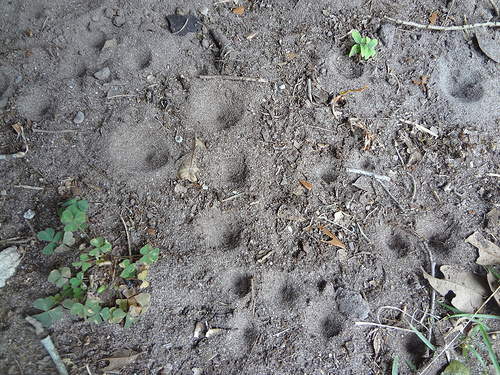
Doodlebug has a huge appetite
By Jessica Therriault, FWC
Ever wonder what digs those cone-shaped indentations in sandy areas of your yard? It is an insect called an ant lion. The ant lion is neither an ant nor a lion. It is a harmless (to people) insect that looks more like a sci-fi movie monster than a real-life backyard critter. It has an appetite to match its ferocious appearance, and its name has everything to do with its favorite meal: ants!
There are approximately 2,000 species of ant lions found throughout the world, mostly in warm climates. Florida has 22 species found throughout the state.
Also called a doodlebug when in its immature or larval stage, the ant lion is unique not only because of how it looks and what it eats but also how it catches its prey. As its nickname suggests, this bug doodles, or makes squiggly lines, while moving backwards in the sand.
Using its jaws to flick away sand, it digs out a cone-shaped pit to trap its prey: ants and other small arthropods that wander too close. It is almost impossible for an ant to climb on the pit’s slope of loose sand, or to escape before falling to the bottom of the pit to become the ant lion’s next meal. Sand pits are about the size of a silver dollar (some smaller, some larger, depending on the size of the maker) and an inch or more deep.

To view ant lion behavior, search for sandy soil in your yard and keep your peepers open for small, cone-shaped indentations in the soil. You may find several in one spot. Favorite pit sites are places protected from the rain, such as beneath a raised building, overhanging eaves or other sheltering object. If you can carefully catch an ant, preferably not a fire ant (we don’t want you to get hurt), drop it into the pit and the ant lion should react quickly. The ant lion waits for its prey under the soil at the bottom of the pit.
If you wish to view one of these insects even closer, scoop it out of the pit with a spoon. Start at one side, scooping under the cone and lift the entire pit in one scoop. Gently dump the pile of sand onto a white sheet of paper and push the sand until you spot the ant lion. It is camouflaged and hard to see. It took me three pits to find one! If you see it and it appears motionless, just wait; it should soon flip over and try to rebury itself in the sand.
Up close, the young ant lion is brownish or grayish in color with a plump body, short legs and a large head dominated by spiny jaws called mandibles that stick out. These jaws have tiny, needle-like teeth that inject their soon-to-be meal with venom. They are usually harmless to touch and rarely bite. If you do find one, it is best not to handle it, and never pick it up with your fingers because its body is super soft and you could hurt it. Simply watch it for a while and then place it gently back on the sand where you found it.
Being an ant bully is only a part of the ant lion’s life cycle. This monster-looking insect transforms into a handsome, winged insect similar to a dragonfly and spends its adult life flying in forested areas, usually in summer months and at night.
So, grab your spoon and Get Outdoors Florida! For more information about ant lions, visit www.ifas.ufl.edu.
